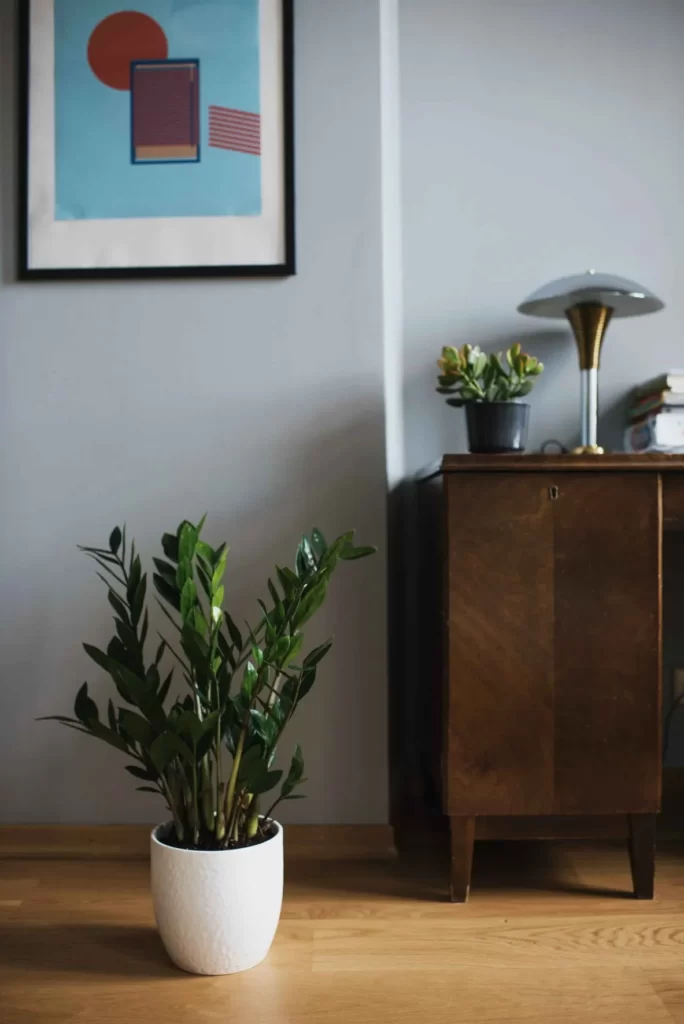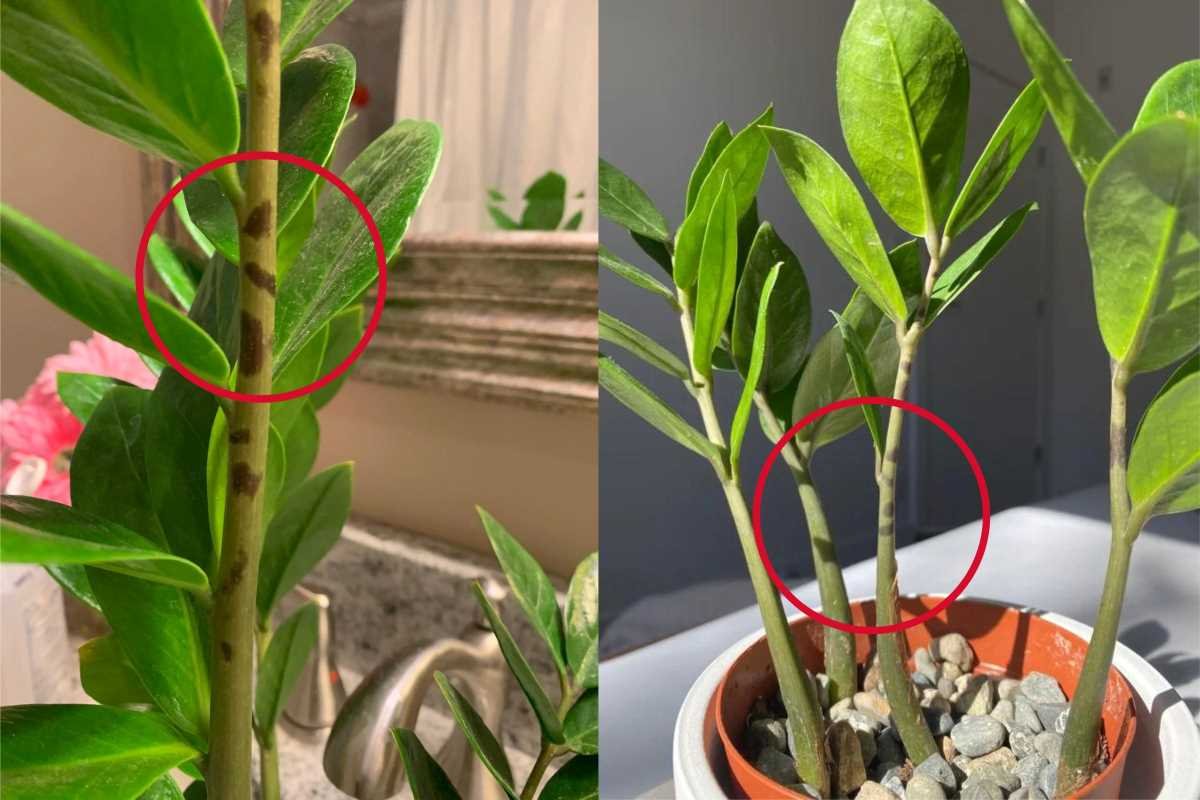The ZZ plant, also known as the Zamioculcas zamiifolia, is a popular houseplant known for its glossy leaves and its ability to thrive in low light conditions.
However, many ZZ plant owners have reported dark spots appearing on the stems of their plants.
In this blog post, we will discuss the causes of these dark spots and provide solutions for preventing and treating them.
What are the Black or Dark Spots for ZZ Plants?
Black or dark spots on ZZ plant stems are a common issue that many plant owners face. There are several potential causes of these dark spots, including over-watering, sunburn, pest infestations, and fungal diseases.
Over-watering can lead to root rot, causing the stems to turn dark and mushy.
Sunburn can cause the stems to turn dark and may also cause the leaves to become yellow and brittle.
Pests like spider mites and mealybugs can feed on the sap of the plant, causing the stems to turn dark and dry.
Fungal diseases such as stem rot can also cause dark spots on the stems, often as a result of overwatering, poor ventilation, or a wound on the stem.
Causes of Black Spots on ZZ Plant Stems

There are few reason for the black spots on Zanzibar Gem (ZZ). Here are we discuss one by one:
1. Over-watering
One of the most common causes of black spots on ZZ plant stems is over-watering. ZZ plants are native to arid regions and do not tolerate waterlogged soil.
When the soil stays too moist for too long, it can lead to root rot, which causes the stems to turn dark and mushy.
To avoid over-watering, make sure to allow the top inch of soil to dry out completely before watering your plant again.
2. Sunburn
Another cause of dark spots on ZZ plant stems is sunburn. Although ZZ plants are able to tolerate low light conditions, they are not tolerant of direct sunlight, especially if they are suddenly exposed to it after being in low light for a long period of time.
Sunburn can cause the stems to turn dark and may also cause the leaves to become yellow and brittle. To prevent sunburn, place your ZZ plant in a location that receives bright, indirect light.
3. Pests
Pests such as spider mites and mealybugs can also cause dark spots on ZZ plant stems. These pests feed on the sap of the plant, causing the stems to turn dark and dry.
To prevent pest infestations, regularly inspect your plant for signs of pests and treat them promptly if you find any.
4. Disease
Dark spots on ZZ plant stems can also be caused by fungal diseases such as stem rot. This disease can be caused by overwatering, poor ventilation, or a wound on the stem.
To prevent stem rot, make sure to provide your ZZ plant with proper care, including proper watering and proper ventilation.
If you think your ZZ plant may have black spot disease, isolate it from other plants and treat it with a fungicide.
In most cases, black spots on ZZ plant stems are not serious and can be treated.
However, black spots on ZZ plant stems are not always a sign of a serious problem. In some cases, the spots may be caused by a natural process called corking. Corking is a way for plants to protect themselves from damage.
If the black spots are widespread or the plant is also showing other signs of stress, it may be a sign of a more serious problem.
If you are concerned about your ZZ plant, it is best to consult with a plant expert.
Solutions for Preventing and Treating Black Spots on ZZ Plant Stems
1. Proper watering

Proper watering is one of the most important steps you can take to prevent dark spots on the stems of your ZZ plant. Over-watering is one of the most common causes of root rot, which can cause the stems to turn dark and mushy.
To properly water your ZZ plant:
- Allow the top inch of soil to dry out before watering your plant again.
- Water your plant thoroughly, ensuring that the water reaches the roots and that the excess water drains away completely.
- Be mindful of the humidity levels in your home, as high humidity can increase the risk of root rot.
- If your plant is in a pot without drainage holes, be extra careful to avoid over-watering, as excess water will not be able to drain away.
By following these simple steps, you can ensure that your ZZ plant receives the right amount of water and stays healthy and free from dark spots on its stems.
Remember, it’s better to underwater your plant than to overwater it, as a plant can recover from under-watering much more easily than it can recover from root rot.
2. Proper lighting

Proper lighting is another important factor in preventing dark spots on the stems of your ZZ plant. Sunburn can cause the stems to turn dark and may also cause the leaves to become yellow and brittle.
To ensure that your ZZ plant receives the right amount of light:
- Place your plant in an area with bright, indirect light. A north or east-facing window is ideal.
- Avoid exposing your plant to direct sunlight, which can cause sunburn.
- If your plant is not receiving enough light, you may need to move it to a brighter location or provide additional artificial lighting.
By providing your ZZ plant with the right amount of light, you can keep it healthy and free from dark spots on its stems. If you notice any yellowing or brittle leaves, consider adjusting the lighting conditions for your plant.
3. Pest control
Pest infestations can also contribute to the development of dark spots on the stems of your ZZ plant. Common pests like spider mites and mealybugs can cause damage to the stems, making them more susceptible to fungal diseases and other forms of stress.
To control pests on your ZZ plant:
- Regularly inspect your plant for any signs of pests, such as small webs or sticky residue on the leaves.
- If you find any pests, take action to eliminate them as soon as possible. You can use insecticidal soap or neem oil to control common pests like spider mites and mealybugs.
- Avoid overcrowding your plant, as this can create conditions that are ideal for pests to thrive.
By taking these steps, you can control pests on your ZZ plant and reduce the risk of dark spots developing on the stems.
If you are unable to control pests using natural or chemical methods, consider seeking help from a professional pest control service.
4. Fungal disease control
Fungal diseases can also cause dark spots to develop on the stems of your ZZ plant. Over-watering, poor air circulation, and damage from pests can all increase the risk of fungal infections.
To control fungal diseases on your ZZ plant:
- Provide your plant with adequate air circulation to reduce the risk of fungal infections.
- Avoid over-watering your plant and ensure that the soil drains well.
- If you notice any dark spots on the stems, isolate the affected plant to prevent the spread of the infection to other plants.
- Consider using a fungicide to control the fungal infection. Choose a fungicide that is suitable for use on indoor plants and follow the instructions carefully.
By taking these steps, you can control fungal diseases on your ZZ plant and reduce the risk of dark spots developing on the stems.
If the fungal infection is severe, it may be necessary to remove and dispose of the affected parts of the plant to prevent the spread of the disease.
Take action in advance
Taking action in advance is key to preventing dark spots on the stems of your ZZ plant. Regularly monitoring your plant for any signs of stress or damage, and taking steps to address any issues as soon as they arise, can help to keep your plant healthy and free from unwanted blemishes.
Here are a few things you can do in advance to prevent dark spots on your ZZ plant:
- Keep a close eye on your plant’s soil moisture levels and adjust your watering schedule as needed.
- Make sure that your plant is positioned in an area with bright, indirect light, away from direct sunlight.
- Regularly inspect your plant for signs of pest infestations, and take steps to control any pests you find as soon as possible.
- Ensure that your plant has good air circulation, and avoid overcrowding it with other plants.
By taking these preventative measures, you can ensure that your ZZ plant stays healthy and free from dark spots on its stems.
If you do encounter any issues, address them promptly to minimize their impact on your plant’s health.
FAQs:
Dark spots on the stems of ZZ plants can be caused by several factors, including over-watering, fungal infections, pest infestations, and sunburn.
To prevent dark spots on the stems of your ZZ plant, ensure proper watering, lighting, pest control, and fungal disease control.
It is not normal for the stems of ZZ plants to turn dark. This can be a sign of a problem, such as over-watering, fungal infections, pest infestations, or sunburn.
In some cases, you may be able to save a ZZ plant with dark spots on the stem by addressing the underlying cause of the problem. If the problem is severe, it may be necessary to remove and dispose of the affected parts of the plant.
The frequency with which you should water your ZZ plant will depend on several factors, including the size of the plant, the light levels, and the temperature. As a general rule, you should allow the top inch of soil to dry out before watering your plant again.
ZZ plants prefer bright, indirect light. A north or east-facing window is ideal. Avoid exposing your plant to direct sunlight, which can cause sunburn.
Conclusion
Black spots on ZZ plant stems can be caused by a variety of factors, including over-watering, sunburn, pests, and disease.
By providing your ZZ plant with proper care, including proper watering, proper lighting, pest control, and fungal disease control, you can prevent and treat these dark spots and keep your plant healthy.
It’s important to be attentive to your plant’s needs and make any necessary changes in a timely manner to ensure its health and well-being.

